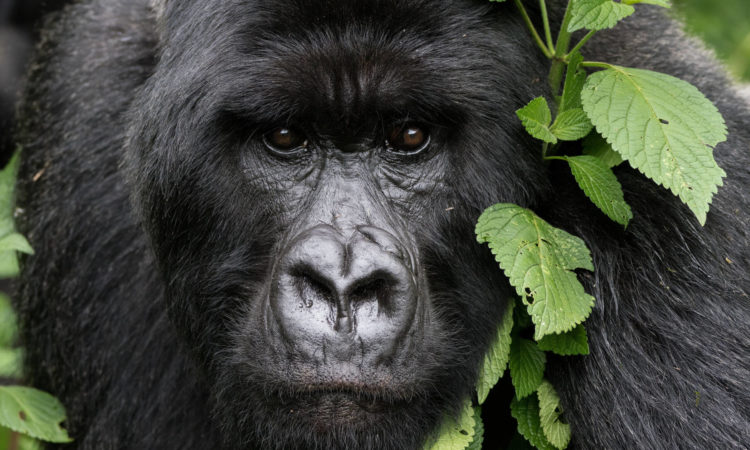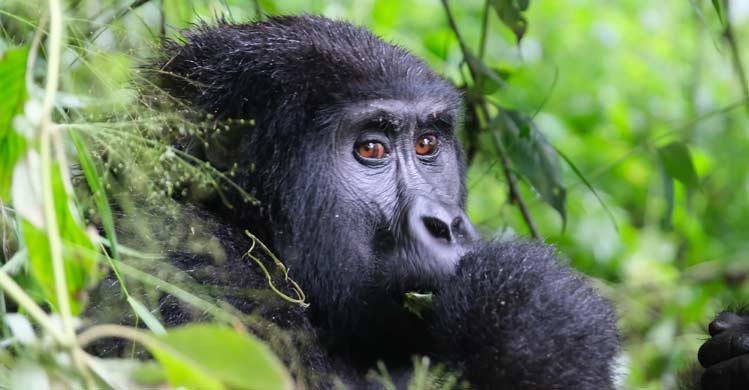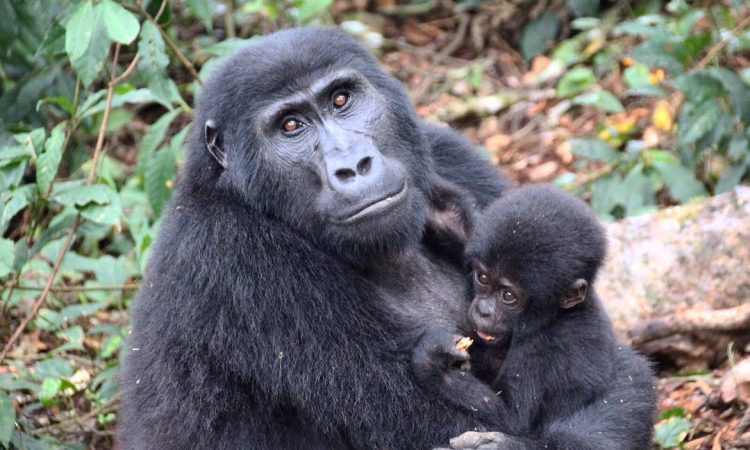
Frequently Asked Questions about Gorilla Trekking
Frequently Asked Questions about Gorilla Trekking : Gorilla trekking is the most common primate activity in five African destinations: Bwindi impenetrable forest national park in southwestern Uganda, Mgahinga gorilla national park in Kisoro district in south western Uganda, Volcanoes national park in northern Rwanda, Virunga national park, and Kahuzi Biega national park in Democratic Republic of Congo. Visitors who wish to see gorillas in their natural habitats commonly have questions about gorilla trekking, and Explore Rwanda Tours has answers to all of the frequently asked questions:
What is Gorilla Trekking?
Gorilla trekking is an exciting activity in which tourists over the age of fifteen travels into the forests in search of endangered gorillas in their natural environment and spend one hour with gorilla families once located.
Where to trek Mountain Gorillas From?
Mountain gorillas are critically endangered primates located in Uganda, Rwanda, and the Democratic Republic of the Congo. Mountain gorillas may be found in Bwindi impenetrable forest national park and Mgahinga gorilla national park in Uganda, Volcanoes national park in Rwanda, and Virunga national park in the Democratic Republic of Congo.
Where can I find Eastern lowland gorillas?
Eastern lowland gorillas vary from mountain gorillas in that they are larger and dwell in places that are less densely forested. The only place in Africa where you can see Eastern lowland gorillas is Kahuzi Biega national park in the Democratic Republic of Congo.
How much is a gorilla trekking permit?
The cost of a gorilla trekking permit is one of the Frequently Asked Questions about Gorilla Trekking and it varies depending on the destination. A gorilla trekking permit in Uganda costs $700 for foreign non-residents, $600 for foreign residents and UGX 250,000 for east African citizens. A gorilla trekking permit in Rwanda costs $1500 for all nationalities, and a gorilla trekking permit in the Democratic Republic of Congo costs $400.
When can I book a gorilla trekking permit?
Gorilla trekking permits in Bwindi Impenetrable Forest National Park, Mgahinga Gorilla National Park, Volcanoes National Park, and Virunga National Park should be booked 3 to 6 months ahead of time since gorilla permits are competitive and sometimes sell out, especially during peak season.

Where can I purchase a gorilla trekking permit?
A gorilla trekking permit in Uganda may be obtained directly from the Uganda Wildlife Authority in Kampala, a gorilla trekking permit in Rwanda from the Rwanda Development Board, and a gorilla trekking permit in the Democratic Republic of Congo from the Virunga tourism office near the Goma border. A gorilla trekking permit may also be obtained by contacting a reputable tour operator, such as Explore Rwanda Tours; with the date, month, and year you wish to hike the gorillas, and we will assist you in obtaining the permission.
How many people are allowed to trek the gorillas?
Bwindi Impenetrable Forest National Park, Mgahinga Gorilla National Park, Volcanoes National Park, Virunga National Park, and Kahuzie Biega National Park all allow a limit of 8 people to hike each gorilla family in Africa. This allows visitors to have a better experience with the gorillas by allowing them to take more photographs and ask questions about them, as well as reducing the gorillas’ behavioral disruption.
How much time can I spend with the gorillas?
Visitors are allowed to spend a maximum of one hour in the presence of gorillas at all gorilla locations. During the one-hour tour, visitors will learn more about the gorillas by asking the guide questions, viewing their lives and habits, taking several photographs using flash-free cameras, and recording moments.
What is the minimum age for gorilla trekking?
Trekking gorillas in Bwindi Impenetrable Forest National Park, Mgahinga Gorilla National Park, Volcanoes National Park, Virunga National Park, and Kahuzi Biega National Park is open to tourists aged 15 and up.
How long does gorilla trekking take?
Gorilla trekking takes between 2 and 7 hours at Bwindi impenetrable forest national park, Mgahinga gorilla national park, Volcanoes national park, Virunga national park, and Kahuzi Biega national park, depending on the gorillas’ location.
How close can I get to the mountain gorillas?
Because gorillas are wild creatures, visitors should keep a distance of 7 meters (21 feet) from them to avoid distracting or frightening them. However, the gorillas may approach near to you at times, but you are not permitted to touch them since they are susceptible to human diseases.
Are the gorillas dangerous?
Gorillas are not dangerous creatures, but they must be treated with caution because if they feel threatened, they will provide warnings such as pounding their chests, grunting, and roaring, among other things, before attacking. You should be cautious when you observe these warnings and step back softly.
When is the best time to trek gorillas?
Gorilla trekking is possible in all places at any time of year, however the ideal months are June to August and December to February during the dry season. Because there will be less rain at this time, the roads to the national parks will be passable, and the gorilla trekking routes will be dry, making trekking more successful than during the rainy season when the trails would be muddy and treacherous. The jungle has short grass during the dry season, which means the gorillas will be visible and you will be able to capture clear photographs.
Can disable people trek mountain gorillas?
Yes, handicapped people can hike gorillas in Uganda’s Bwindi Impenetrable Forest National Park and Mgahinga Gorilla National Park, where they will be transported to gorilla habitats in stretcher beds by porters.
Where to stay during gorilla trekking safari?
Where to stay during these safaris is one of the Frequently Asked Questions about Gorilla Trekking. Within and around gorilla trekking sites in Africa, there are a number of luxury, midrange, and economy hotels where tourists on a gorilla trekking safari can stay depending on their budget. The lodges include amenities such as comfortable rooms, laundry facilities, room service, free Wi-Fi, a swimming pool, a well-stocked bar with a variety of drinks, traditional and foreign cuisine, and relaxing gardens, among others.

What to pack for a gorilla trekking safari?
- Hiking shoes: Because gorillas dwell in the forest, which is frequently damp, it is essential to use hiking shoes that are comfortable and allow for easy mobility when trekking.
- Garden gloves, which will protect your hands from bacteria and thorns while torching the forest’s flora and trees for support.
- Long-sleeved shirt and pants; long-sleeved clothing will keep you warm in the forest while also protecting your body from prickly plants and trees.
- Insect repellent: Because the forests are home to a variety of insects, such as mosquitos and tsetse flies, a pest repellent will protect you from insect bites.
- Energy snacks: It is recommended to have energy snacks such as drinking water, packed meals, and biscuits when going gorilla trekking because gorilla trekking is unpredictable and can take 2 to 6 hours or even longer depending on the location of the gorillas.
- Camera: The camera will be utilized to capture numerous photographs as well as record films and moments to share with family and friends back home.
- Binoculars: A pair of binoculars will be needed to see distant bird species, as all gorilla locations are birding regions with gorillas lurking in the bushes.
- Backpack: You’ll use the backpack to carry all of your supplies, such as bug repellant, energy foods, and a camera, among other things.
- A waterproof rain jacket will keep you dry if it rains while you’re walking through the forest.
What are the rules and regulations for gorilla trekking?
- Do not leave trash in the forest; thus, carry all of your belongings back with you after your hike.
- When trekking, keep your voices quiet and stay with your group to avoid getting lost in the bush.
- Do not smoke, eat, or drink anything when close or in the company of gorillas, since food particles may fall to the ground, increasing the risk of disease transmission.
- Because gorillas are wild creatures, do not set fire to them.
- When shooting photographs, choose cameras with less flashes.
- If the gorillas charge, follow the guide’s advice by not staring them in the eyes, not attempting to flee, crunching down gently, and leaving their presence.
- Keep a 7-meter distance between you and the gorillas to prevent them from contracting human illnesses.
- If you become unwell, you should stay at home and your money will be reimbursed because gorillas are susceptible to human infections.
- If you need to use the restroom in the forest, the guide will dig a 30 cm deep hole and cover it after you’ve finished.
What other activities can I do apart from gorilla trekking?
Bird watching, nature walks, and Batwa trail experience in Bwindi Impenetrable Forest national park, Golden monkey trekking, mountain climbing, bird watching, natural walk, and Batwa trail in Mgahinga gorilla national park, Musanze caves exploration, Golden monkey trekking, and Ibyi’wacu cultural village in Mgahinga gorilla national park, Musanze caves exploration, Golden monkey trekking, and Ibyi’wacu cultural village in Volcanoes national park. In the Democratic Republic of Congo, you can take part in Chimpanzee trekking, nature walks, landscape viewing, Nyiragongo hiking, nature walks, bird watching in Virunga national park, nature walks, mountain climbing, bird watching in Kahuzi Biega national park, and visiting the Lwiro Rehabilitation Centre As a result, when you go gorilla trekking in one of the national parks, you may also partake in other activities, making your safari even more thrilling and memorable.
Conclusion: You may contact Explore Rwanda Tours for additional information on gorilla trekking queries by contacting our expert tour advisors by email, phone calls, or browsing the blogs on our websites.


